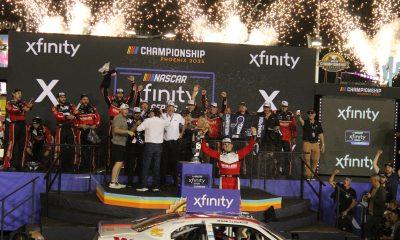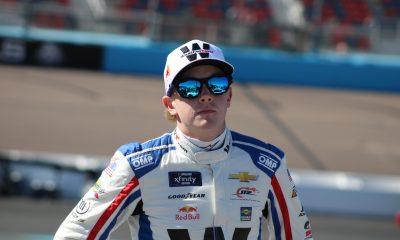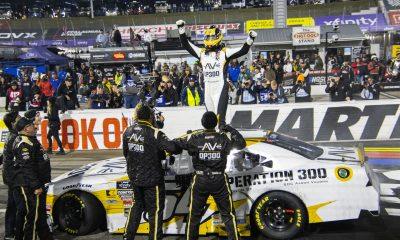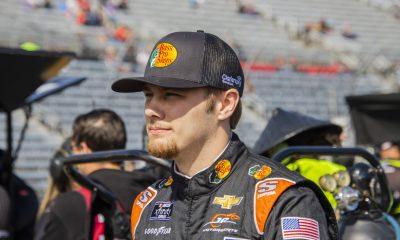
Corey Day (No. 17) continues to excel and evolve in his part-time schedule with Hendrick Motorsports’ No. 17 team. (Photo: Nigel Kinrade | Nigel Kinrade Photography)
RIDGEWAY, Va. — At just 19 years old, Corey Day is emerging as a young talent to watch in the NASCAR Xfinity Series. Driving part-time for Hendrick Motorsports in the No. 17 Hendrickcars.com Chevrolet, Day has made rapid strides in adapting from dirt track racing to asphalt, highlighted by a strong fourth-place finish at Las Vegas Motor Speedway earlier this month.
“I think it was just a good day, top to bottom for my confidence,” Day said about his performance in Las Vegas. “Just from an experience perspective, starting 19th and passing cars to race in the top five was really good too.”
A Breakthrough in Vegas
For a driver still gaining familiarity with stock cars, Las Vegas represented a turning point. Day credited his performance to both preparation and execution on race day.
“Yeah, I think just a mix of all of it,” he said. “We had a really good car. I’m finally at the point where I feel really comfortable in the car. I think that was my ninth Xfinity race. I’m finally getting seat time to be comfortable in the car and figuring out the racecraft side of things. Overall, I just think it was a good day for me and the seat. The team, the car was phenomenal. Everything clicked for sure.”
Vegas not only tested Day’s technical abilities but also his ability to communicate effectively with his crew chief, Adam Wall. The combination of car performance and teamwork allowed Day to focus on racing aggressively, a skill that takes time to cultivate for drivers transitioning from dirt to asphalt.
From Dirt Tracks to Asphalt
Day began his racing career on dirt tracks in California, where the fast-paced, short-lap racing environment required quick reactions and constant movement. Translating those instincts to longer asphalt races has been a learning process.
“Getting comfortable racing around cars has been a big one for me this year,” Day explained. “With the sprint car side of things, you’re never really wheel-to-wheel for that long. You just pass each other back and forth. It’s just a lot faster paced.
“So I think learning the side draft and where to position the car has been big for me. I’ve had to learn that in four different cars this year now. So the Xfinity car is kind of the last one I have to figure out. I feel like I got a good handle on that part of it at Vegas.”
Adjusting Strategy and Patience

Corey Day has learned a great deal from taking on the tenacious bullrings of sprint car racing to a winding road course like Charlotte Motor Speedway ROVAL. (Photo: Hendrick Motorsports)
Day’s adaptation goes beyond technique. Learning patience on the track has been an essential lesson.
“When someone’s behind me, that’s way faster than me,” he said. “I’m not used to letting someone go. I race all I can in a dirt car. So it’s definitely been different for me to be like, okay, go ahead. I still got 150 laps to race you. That’s been a big thing I’ve learned too, just letting the race play out. Martinsville, with heated tempers, it’s definitely easy to piss someone off and get your day ended quick.”
The mental shift from being in constant control to pacing oneself over the course of a race reflects the broader transition from dirt to asphalt racing. Day’s ability to adapt in this area has been a critical factor in his strong finishes.
Mentorship from Kyle Larson
A cornerstone of Day’s development has been his mentorship with friend and Cup Series star Kyle Larson, who has navigated the same transition from dirt to pavement.
“Kyle’s been incredible at putting things into my terms,” Day said. “He’s among the short list of guys in the sport that kind of see things the way I do coming from the dirt side. Even when I don’t understand something, he’s there to help me out with that. I’ve evolved to understand engineer talk now. That’s a lot better than it was.”
The relationship with Larson has given Day a blueprint for racing at higher levels. Larson’s guidance on communication with engineers, car handling, and race strategy has accelerated Day’s learning curve in ways practice alone could not achieve.
Learning From Experience
For Day, each race weekend provides a critical learning opportunity. He approaches each track differently while trying to carry forward the lessons from past events.
“You know, I don’t really know. I always try to do the same thing I did the weekend before if it went well,” Day said. “Vegas is vastly different than Martinsville, right? You’re going to approach Martinsville different than Vegas. But you just start the day strong with a good practice and get a good read on your stuff. That leads the team in the right direction.”
Experience has also helped him approach repeat tracks with confidence.
“When you go into something your first time, there’s a lot of nerves,” Day shared. “A lot of unsureness. That’s all gone now. I know what to expect. I’m confident in my race car. I feel like our race car is really good there and in March. All that questioning yourself is out the window, so you can focus on the task at hand.”
Building Routine and Comfort

Corey Day leans on his No. 17 teammates like crew chief Adam Wall. (Photo: Nigel Kinrade | Nigel Kinrade Photography)
Day has found that building a routine similar to full-time drivers helps his performance. Consecutive race experiences allow him to focus on incremental improvements rather than simply surviving race weekends.
“Getting into a routine has been huge for me,” he said. “It’s helped me feel comfortable and allowed me to focus on improving every week. I thought it would take until Phoenix to feel this way, but Vegas proved I’m ahead of that curve.”
This routine, combined with growing confidence, allows Day to focus on refining racecraft, adapting to various tracks, and understanding the dynamics of stock car competition.
Setting Goals for the Season
While statistics matter, Day emphasizes personal growth as the primary measure of success this year.
“I honestly feel like I’m in a really good spot,” he said. “Just getting the routine, getting that comfortability, being able to work on something new every week. I feel like I’m quicker there than I thought I would be. Vegas proved that. If I were to get more comfortable on a short track like Martinsville, that would be another big one for me to check off.”
He also noted that internal benchmarks—feeling confident in the car, executing strategy effectively, and learning to manage racing situations—are as important as top finishes.
Looking Ahead

Corey Day shed some light on his 2026 plans. (Photo: Matthew T. Thacker | Nigel Kinrade Photography)
As the season continues, Day is optimistic about future opportunities. While he cannot yet reveal his full schedule for next year, he confirmed his plans include a return to Rick Hendrick’s organization.
“I will still be driving for Hendrick Motorsports on a to-be-determined schedule,” Day said. “I’ll still be pavement racing with Hendrick Motorsports. That’s all I can say right now.”
Even at a young age, Day understands the value of fan support and recognition.
“I guess just thanks for the support,” he said. “It’s cool to see all you guys watching and wanting the best for me. So thank you.”
A Young Driver on the Rise
Corey Day’s journey illustrates the balance between raw talent, mentorship, and adaptability. With a strong foundation from dirt track racing, guidance from Larson, and experience gained on the Xfinity circuit, he is steadily finding his rhythm.
As Day continues to compete in part-time Xfinity events, the combination of patience, preparation, and skill promises to pay dividends. His Las Vegas performance offers a glimpse of what’s possible, and the upcoming races at Martinsville and beyond will be a test of whether that momentum can continue. At just 19, Corey Day is already showing that with the right support and mindset, a young driver can make a significant impact in NASCAR.
Editor’s Notes
Special thanks to Corey Day for taking time this week for this exclusive interview for The Podium Finish! Also, special thanks to Bailey Black of Hendrick Motorsports for her kindness and guidance with this opportunity.
Be sure to head over to TPF+ and subscribe now for the long form, uncut feature story and full video interview with Corey and other stars from the world of motorsports and basketball!
Rob Tiongson is a sports writer and editor originally from the Boston area and resides in the Austin, Texas, area. Tiongson has covered motorsports series like NASCAR and INDYCAR since 2008 and NHRA since 2013. Most recently, Tiongson is covering professional basketball, mainly the WNBA, and women's college basketball. While writing and editing for The Podium Finish, Tiongson currently seeks for a long-term sportswriting and sports content creating career. Tiongson enjoys editing and writing articles and features, as well as photography. Moreover, he enjoys time with his family and friends, traveling, cooking, working out and being a fun uncle or "funcle" to his nephew, niece and cat. Tiongson is an alum of Southern New Hampshire University with a Bachelor of Arts in Communication and St. Bonaventure University's renowned Jandoli School of Communication with a Master of Arts in Digital Journalism.












